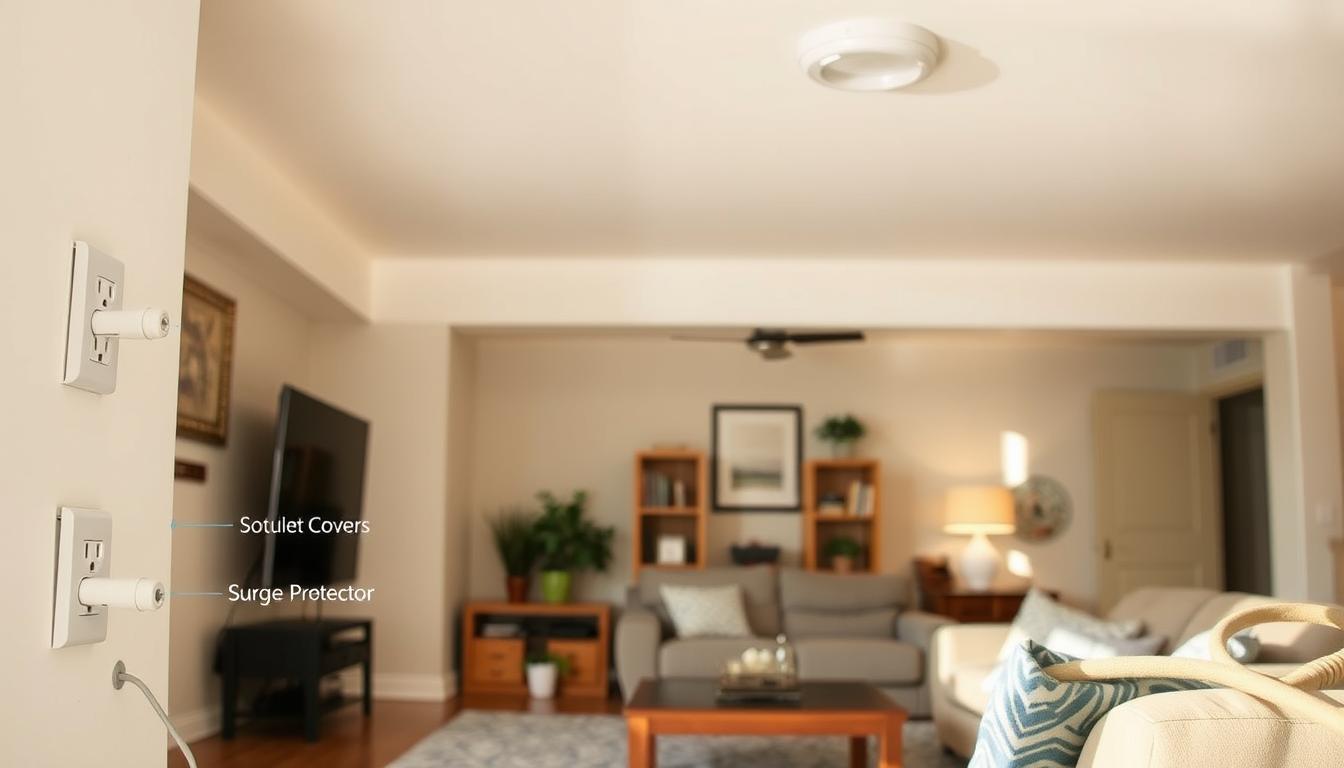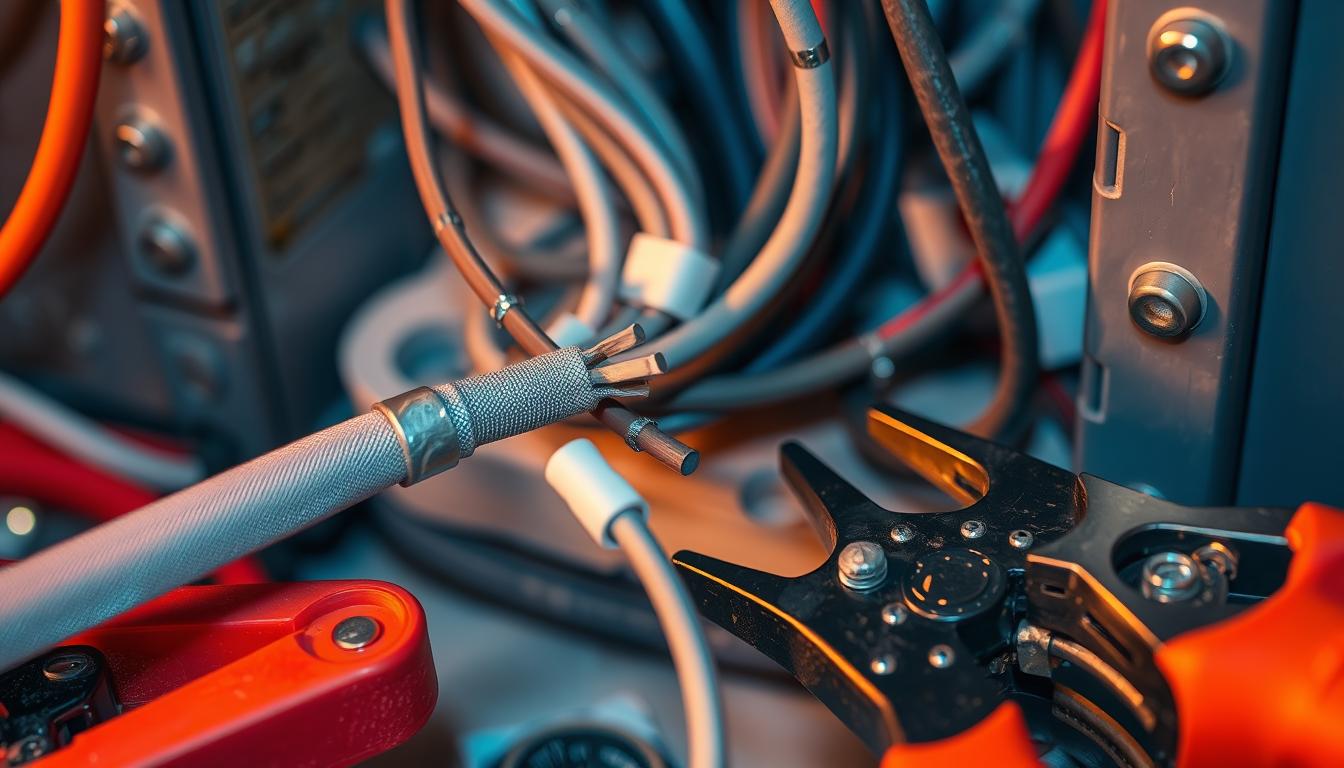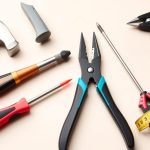Keeping your home safe from electrical dangers is key to your family’s well-being. Knowing how to prevent electrical accidents is very important. By being proactive, you can greatly lower the chance of electrical mishaps.
Setting up safety measures and preventing risks can shield your home and family from electrical dangers. This article will give you a detailed look at electrical safety. It will show you why safety protocols and risk prevention are vital every day.
By focusing on electrical safety, you can make your home a safer place for your family. It’s about knowing the dangers and taking steps to avoid them. This way, you can keep your family safe with the right safety measures and risk prevention.
Introduction to Electrical Safety
Many people don’t think about electrical safety until something goes wrong. It’s important to know the basics of electrical safety and act early to avoid accidents. By doing this, you can make your home a safer place for your family with the right safety steps and risk prevention.
Key Takeaways
- Electrical safety is crucial for home maintenance and family safety
- Implementing safety protocols can reduce the risk of electrical accidents
- Risk prevention strategies are essential in protecting homes and loved ones
- Understanding electrical safety basics is vital for homeowners
- Proactive measures can help prevent electrical hazards
- Effective safety protocols and risk prevention can create a safer living environment
Understanding the Basics of Electrical Safety
Electrical safety is key to keeping your home and family safe. Knowing the basics helps you spot dangers like faulty wiring and outdated systems. This knowledge lets you navigate your home’s electrical system safely.
Following safety standards is crucial. This means using protective equipment like circuit breakers. Also, learning about grounding helps you find and fix potential hazards.
Common Electrical Hazards in Homes
Some common dangers in homes include:
- Faulty wiring and outdated electrical systems
- Misuse of electrical appliances, such as overloading circuits
- Failure to use protective equipment, such as circuit breakers and fuse boxes
The Impact of Electrical Accidents
Electrical accidents can cause serious harm, including injuries and fatalities. It’s vital to prevent these by following safety standards and using protective equipment.
Key Safety Terms and Concepts
Knowing terms like grounding and circuit breakers is important. It helps you spot and fix dangers. By learning these and following safety standards, you can keep your family safe.
| Term | Definition |
|---|---|
| Grounding | A safety measure that prevents electrical shock by directing current to the ground |
| Circuit Breaker | A device that interrupts an electrical circuit in case of an overload or short circuit |
| Fuse Box | A device that contains fuses that melt and interrupt an electrical circuit in case of an overload or short circuit |
Essential Protective Equipment for Electrical Safety
Having the right protective equipment is key for electrical safety. This gear acts as a shield against electrical dangers. It helps prevent accidents and ensures emergency procedures are ready. Important items include insulating gloves, safety glasses, and ground fault circuit interrupters (GFCIs).
It’s important to know how to use this equipment correctly. For example, knowing how to use a fire extinguisher for electrical fires or how to do CPR for electrical shock can save lives. By following best practices and using protective gear, homeowners can greatly improve their electrical safety.
Some key protective equipment to consider includes:
- Insulating gloves
- Safety glasses
- Ground fault circuit interrupters (GFCIs)
- Fire extinguishers rated for electrical fires
By following emergency procedures and best practices, we can lower the risk of electrical accidents. It’s crucial to stay updated on the latest safety gear and protocols. This ensures a safe and secure home for everyone.
Electrical safety is a top concern, and the right equipment is just the start. By combining this gear with best practices and knowing emergency procedures, we can make our homes safe for ourselves and our families.
| Protective Equipment | Description |
|---|---|
| Insulating gloves | Protect hands from electrical shock |
| Safety glasses | Protect eyes from electrical arcs and flashes |
| Ground fault circuit interrupters (GFCIs) | Interrupt electrical circuits in case of a ground fault |
Signs of Electrical Problems in Your Home
Spotting electrical issues early is key to keeping your home safe. Knowing the signs helps you act fast to avoid accidents. Safety protocols are important for quick and right action when electrical problems arise.
Look out for signs in wiring, outlets, and switches. Frayed cords, hot wires, and burning smells are red flags. Also, watch for outlets and switches that spark, get too hot, or don’t work right. Appliances that malfunction, spark, or make odd noises are also warning signs.
Warning Signs to Watch Out For
- Frayed or damaged cords and wires
- Overheated outlets, switches, or appliances
- Burning smells or unusual odors
- Sparking or arcing from outlets or switches
- Appliances that malfunction or produce unusual noises
Having a plan for emergency response is crucial. Know what to do in an electrical fire or shock. Keep safety gear and important phone numbers handy. Being ready and proactive can prevent accidents and keep your family safe.
Proper Maintenance of Electrical Systems
Regular maintenance is key to avoiding risks and meeting safety standards in electrical systems. Homeowners can greatly lower the risk of electrical dangers by keeping up with maintenance. Risk prevention is vital for electrical safety. It’s done by checking wiring, outlets, and appliances regularly to spot and fix problems early.
Following safety standards, like those from the National Electrical Code (NEC), is important for homeowners. This means sticking to rules for setting up and caring for electrical systems. Some important maintenance steps include:
- Regularly checking wiring and outlets for wear and tear signs
- Making sure all electrical appliances are correctly installed and cared for
- Keeping electrical systems current with the newest safety features and tech
By doing these things, homeowners can avoid electrical accidents and make sure their systems work well and safely.
Regular upkeep not only stops electrical accidents but also makes electrical parts last longer. This means you won’t have to spend a lot on fixing or replacing them. As a homeowner, making risk prevention and following safety standards a priority is crucial. It keeps your family safe and your electrical systems working well for a long time.
Proper maintenance of electrical systems is a critical aspect of home safety, and it requires a proactive approach to identify and address potential hazards before they become major issues.
Child-Proofing Your Home’s Electrical Systems
As a parent, keeping your child safe is your main goal. One key part of home safety is making sure your electrical systems are child-proofed. This means stopping kids from getting to outlets, cords, and appliances. These can be dangerous if not used right.
Using protective gear and following best practices can lower the risk of electrical accidents. This is very important for your child’s safety.
Effective ways to child-proof your home’s electrical systems include socket and outlet protection. You can use tamper-resistant outlets or outlet covers. This stops kids from putting things into outlets, which can be very dangerous.
Also, safe cord management is key. This means keeping cords away from kids and not overloading outlets. This helps prevent fires and other accidents.
Teaching Children About Electrical Safety
Teaching kids about electrical safety is also crucial. Start early to teach them about the dangers of electrical appliances. Tell them not to play with cords and what to do in an electrical emergency.
By following these steps and using protective gear, you can keep your kids safe. This helps prevent electrical accidents.
Some important tips for child-proofing your home’s electrical systems include:
- Using outlet covers or tamper-resistant outlets
- Securing cords out of reach
- Avoiding overload on electrical outlets
- Teaching children about electrical safety
By following these tips and using protective equipment, you can help keep your children safe. This prevents electrical accidents.
Weather-Related Electrical Safety Protocols
It’s important to know about electrical safety during bad weather. Storms and floods can damage electrical systems. Having a plan for backup lights and power is key.
When weather gets bad, follow safety protocols. Secure outdoor electrical stuff and don’t use appliances in floods. Also, watch out for downed power lines and know what to do in an electrical emergency.
Some important tips for electrical safety in bad weather are:
- Secure outdoor electrical equipment, like generators and panels
- Don’t use electrical appliances in floods
- Be careful of downed power lines and know how to handle electrical emergencies
By sticking to these safety protocols and having emergency procedures, you can lower the risks of electrical hazards. This makes your home safer and more secure.
Smart Home Technology and Electrical Safety
Smart home technology has changed how we keep our homes safe from electrical dangers. It uses advanced tech to make our homes safer and lower risks. One big plus is that it lets us watch our electrical systems in real-time and get alerts fast.
This is key for risk prevention. It helps us spot electrical dangers early. Also, smart tech helps us follow safety standards better. It does this with automated shut-offs and smart circuit breakers that catch and fix electrical problems better than old systems.
Modern Safety Features
Smart home tech comes with cool safety features. These include automated shut-offs, smart circuit breakers, and arc fault detection. These help stop electrical accidents and fires.
Smart Detection Systems
Smart detection systems find electrical problems early. They warn us about overheating, electrical surges, and other dangers. This gives us a chance to act fast.
Integration with Emergency Services
Smart home tech also works with emergency services. If there’s an electrical emergency, it alerts help quickly. This means faster help and less chance of harm or damage.
Using these techs and following safety standards makes our homes safer. It’s crucial for risk prevention. It helps us catch electrical dangers before they get worse.
| Smart Home Technology Feature | Description |
|---|---|
| Automated Shut-Off Systems | Automatically shut off power in case of an electrical issue |
| Smart Circuit Breakers | Detect and respond to electrical hazards more effectively than traditional systems |
| Arc Fault Detection | Detect and prevent electrical arcs that can cause fires |
Professional Inspection and Maintenance Guidelines
Regular professional inspections are key to keeping a home’s electrical system safe. By sticking to safety rules and best practices, homeowners can avoid electrical dangers. It’s important to know when to call an electrician, like when you see signs of electrical issues or before you start DIY electrical work.
When to Call an Electrician
Call an electrician if you notice flickering lights, warm outlets, or burning smells. It’s also wise to hire an electrician before you start any DIY electrical projects. This ensures the work is done right and safely.
Certification Requirements
Electricians need to meet certain standards to do their job well. Homeowners should look for electricians who are licensed and certified by trusted organizations.
Maintenance Schedules
Regular maintenance helps prevent electrical dangers. Homeowners should set up a schedule for inspections and upkeep. This includes checking for damaged wires, loose connections, and outdated systems.
By following these guidelines and setting up a maintenance routine, homeowners can keep their homes safe from electrical risks. Always put safety first when dealing with electrical work.
| Inspection Type | Frequency | Purpose |
|---|---|---|
| Visual Inspection | Annual | To identify signs of wear and tear |
| Electrical System Check | Every 5 years | To ensure the electrical system is up-to-date and functioning correctly |
| Emergency Preparedness Check | Every 2 years | To ensure that emergency equipment, such as smoke detectors and carbon monoxide detectors, are functioning correctly |
Emergency Response and First Aid for Electrical Accidents
In case of an electrical accident, knowing how to react is key. Emergency response means calling for help and acting fast to avoid more harm. If it’s safe, turn off the power source. Knowing safety standards is crucial for a good outcome.
First aid for electrical accidents includes treating burns and heart issues from shock. Being ready and knowing how to act can save lives and lessen injuries. Important steps in emergency response are:
- Calling 911 or the local emergency number
- Turning off the power source if it is safe to do so
- Providing first aid, such as CPR or burn treatment, if necessary
By following safety standards and staying informed, you can handle electrical accidents well. Keeping up with the latest emergency response methods is also vital for the best results.
Creating Your Home’s Electrical Safety Plan
Creating a detailed electrical safety plan is key to avoiding accidents and being ready for emergencies. By setting up good safety measures, homeowners can lower the chance of electrical dangers. A solid plan should list possible electrical risks, have checklists for upkeep, and have family emergency steps.
To make a strong safety plan, think about these important parts:
- Find and list electrical dangers in your home, like old wiring or broken appliances
- Make a plan for regular checks and upkeep to avoid risks
- Set up clear family emergency steps, like where to go and who to call
Running safety drills often is also key. It makes sure everyone knows what to do in an electrical emergency. With safety steps in place and the plan updated often, homeowners can keep their families safe.
Documentation and Checklists
Keeping up with accurate records and checklists is crucial for safety. This means keeping track of electrical checks, upkeep, and fixes. Also, make lists for safety drills and emergency steps.
Family Emergency Procedures
Having clear family emergency steps is vital for quick and right action in an electrical emergency. This includes picking a meeting spot outside, knowing emergency numbers, and practicing escape routes.
Conclusion: Ensuring Long-Term Electrical Safety for Your Family
Keeping your home safe and secure is a big job. It needs a strong focus on safety standards and best practices. By being informed and taking action, families can keep their homes safe for a long time. This lets them enjoy their homes without worry.
It’s important to remember that electrical safety never stops. You should always check your home’s electrical systems, update safety plans, and teach your family about safety. Doing these things helps keep your family safe from electrical dangers.
Starting to make your home safer is a big step. Use the tips from this article to help. Stay alert and always put electrical safety first. With these steps, we can make homes safer for families to live in, free from dangers.




